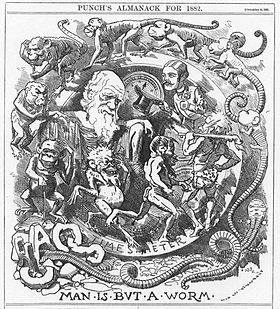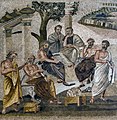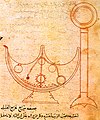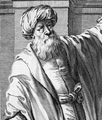Portal:History of science
The History of Science Portal
The history of science covers the development of science from ancient times to the present. It encompasses all three major branches of science: natural, social, and formal. Protoscience, early sciences, and natural philosophies such as alchemy and astrology during the Bronze Age, Iron Age, classical antiquity, and the Middle Ages declined during the early modern period after the establishment of formal disciplines of science in the Age of Enlightenment.
Science's earliest roots can be traced to Ancient Egypt and Mesopotamia around 3000 to 1200 BCE. These civilizations' contributions to mathematics, astronomy, and medicine influenced later Greek natural philosophy of classical antiquity, wherein formal attempts were made to provide explanations of events in the physical world based on natural causes. After the fall of the Western Roman Empire, knowledge of Greek conceptions of the world deteriorated in Latin-speaking Western Europe during the early centuries (400 to 1000 CE) of the Middle Ages, but continued to thrive in the Greek-speaking Byzantine Empire. Aided by translations of Greek texts, the Hellenistic worldview was preserved and absorbed into the Arabic-speaking Muslim world during the Islamic Golden Age. The recovery and assimilation of Greek works and Islamic inquiries into Western Europe from the 10th to 13th century revived the learning of natural philosophy in the West. Traditions of early science were also developed in ancient India and separately in ancient China, the Chinese model having influenced Vietnam, Korea and Japan before Western exploration. Among the Pre-Columbian peoples of Mesoamerica, the Zapotec civilization established their first known traditions of astronomy and mathematics for producing calendars, followed by other civilizations such as the Maya.
Natural philosophy was transformed during the Scientific Revolution in 16th- to 17th-century Europe, as new ideas and discoveries departed from previous Greek conceptions and traditions. The New Science that emerged was more mechanistic in its worldview, more integrated with mathematics, and more reliable and open as its knowledge was based on a newly defined scientific method. More "revolutions" in subsequent centuries soon followed. The chemical revolution of the 18th century, for instance, introduced new quantitative methods and measurements for chemistry. In the 19th century, new perspectives regarding the conservation of energy, age of Earth, and evolution came into focus. And in the 20th century, new discoveries in genetics and physics laid the foundations for new sub disciplines such as molecular biology and particle physics. Moreover, industrial and military concerns as well as the increasing complexity of new research endeavors ushered in the era of "big science," particularly after World War II. (Full article...)
Selected article -

Recurring cultural, political, and theological rejection of evolution by religious groups exists regarding the origins of the Earth, of humanity, and of other life. In accordance with creationism, species were once widely believed to be fixed products of divine creation, but since the mid-19th century, evolution by natural selection has been established by the scientific community as an empirical scientific fact.
Any such debate is universally considered religious, not scientific, by professional scientific organizations worldwide: in the scientific community, evolution is accepted as fact, and efforts to sustain the traditional view are universally regarded as pseudoscience. While the controversy has a long history, today it has retreated to be mainly over what constitutes good science education, with the politics of creationism primarily focusing on the teaching of creationism in public education. Among majority-Christian countries, the debate is most prominent in the United States, where it may be portrayed as part of a culture war. Parallel controversies also exist in some other religious communities, such as the more fundamentalist branches of Judaism and Islam. In Europe and elsewhere, creationism is less widespread (notably, the Catholic Church and Anglican Communion both accept evolution), and there is much less pressure to teach it as fact. (Full article...)
Selected image

This famous sequence of photographs, depicting a horse in motion, was created by Eadweard Muybridge in 1904. His technique involved multiple cameras, linked by an electrical trigger, to capture many images in rapid succession. Muybridge demonstrated this and many other sets of motion photographs to the public using his zoopraxiscope, a precursor of motion pictures.
Did you know
...that Einstein's famous letter to FDR about the possibility of an atomic bomb was actually written by Leó Szilárd?
...that geology was transformed in the latter part of the 20th century after widespread acceptance of plate tectonics?
...that the idea of biological evolution dates to the ancient world?
Selected Biography -
Nikola Tesla (/ˈnɪkələ ˈtɛslə/; Serbian Cyrillic: Никола Тесла, [nǐkola têsla]; 10 July 1856 – 7 January 1943) was a Serbian-American engineer, futurist, and inventor. He is known for his contributions to the design of the modern alternating current (AC) electricity supply system.
Born and raised in the Austrian Empire, Tesla first studied engineering and physics in the 1870s without receiving a degree. He then gained practical experience in the early 1880s working in telephony and at Continental Edison in the new electric power industry. In 1884 he immigrated to the United States, where he became a naturalized citizen. He worked for a short time at the Edison Machine Works in New York City before he struck out on his own. With the help of partners to finance and market his ideas, Tesla set up laboratories and companies in New York to develop a range of electrical and mechanical devices. His AC induction motor and related polyphase AC patents, licensed by Westinghouse Electric in 1888, earned him a considerable amount of money and became the cornerstone of the polyphase system which that company eventually marketed. (Full article...)
Selected anniversaries
- 1462 – Birth of Johannes Trithemius, German cryptographer (d. 1516)
- 1897 – Death of Constantin von Ettingshausen, Austrian geologist (b. 1826)
- 1903 – Death of George Gabriel Stokes, Irish physicist (b. 1819)
- 1918 – Russia adopts the Gregorian calendar
- 1958 – Death of Clinton Davisson, American physicist, Nobel Prize Laureate (b. 1888)
- 1970 – Death of Alfréd Rényi, Hungarian mathematician (b. 1921)
- 1976 – Death of Werner Heisenberg, German physicist, Nobel Prize Laureate (b. 1901)
- 1976 – Death of George Whipple, American scientist, Nobel Prize Laureate (b. 1878)
Related portals
Topics
General images
Subcategories
Things you can do
Help out by participating in the History of Science Wikiproject (which also coordinates the histories of medicine, technology and philosophy of science) or join the discussion.
Associated Wikimedia
The following Wikimedia Foundation sister projects provide more on this subject:
-
Commons
Free media repository -
Wikibooks
Free textbooks and manuals -
Wikidata
Free knowledge base -
Wikinews
Free-content news -
Wikiquote
Collection of quotations -
Wikisource
Free-content library -
Wikiversity
Free learning tools -
Wiktionary
Dictionary and thesaurus









































































